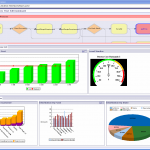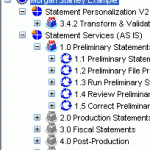 The saying “A picture’s worth a thousand words” isn’t always true. It’s certainly not true when it comes to process modeling. Why?
The saying “A picture’s worth a thousand words” isn’t always true. It’s certainly not true when it comes to process modeling. Why?
Pictures are flat. They have two dimensions. Models have three dimensions. A process model can have many dimensions. A detailed process model is the result of process discovery.
What is Process Discovery?
Process discovery is the action of understanding and documenting how a business process works. To gain this understanding requires interviewing the process owner. During the interview your objective is to gain understanding about process flow and to capture any relevant process metrics. The final step of discovery is to document the process knowledge you discover.
Enterprise process discovery is the initial step a company takes in becoming process focused. Discovery starts with understanding the current state of a business process. The AS IS or current state process model provides a baseline for gap analysis.
Part of any process analysis is to compare the current state to future state process models. Comparing a future state or a TO BE model to the AS IS can validate if business justification exists for potential process changes.
Discovery typically requires the business analyst interview subject matter experts to acquire process knowledge. Interviews![]() are done more efficiently when performed in parallel. Divide and conquer!
are done more efficiently when performed in parallel. Divide and conquer!
Start your interview by asking the subject matter expert to describe the process. Send the interviewee questions in advance so they can prepare. That will help you get more detail during the interview.
During an interview ask open-ended questions. Ask questions like: Describe what initiates the process. What’s done first? Who does it? How much time does it take? Describe the resources involved. Are there inputs needed to start the process? Open ended questions will encourage process owners to be detailed with their answers.
Ask the subject matter expert to prioritize process issues along with any opportunity for improvement they believe exist. It’s normal to get over whelmed by the volume of information uncovered during an interview.
 Business Process Modeling Tools
Business Process Modeling Tools
A modeling tool can help you manage the volumes of process knowledge captured during interviews. Process modeling tools come standalone or as part of an integrated suite of tools. BPA is the acronym used for business process modeling and analysis tools.
BPA functionality ranges from simple process diagram drawing to data driven modeling and analysis. The tool you choose will dictate your discovery effort and the quality of the process documentation produced. Quality process documentation can be aside effect of discovery if you choose the right BPA tool. What else should you considered when choosing a modeling tool?
Many business analysts are comfortable using stencil driven drawing tools, spreadsheets and a word processors for process modeling. Drawing tools create beautiful pictures but try to perform a cycle time analysis with one. A BPA tool needs more than just a drawing palette. Choose a data driven business process modeling tool.
Data Driven Process Models
Data driven means a process model is represented by underlying data relationships and not by a collection of symbols in a picture. A data driven BPA tool can draw a process diagram from the underlying model data. Modify the data and the way the process diagram is drawn changes. Query the data and the result can be a swim lane diagram highlighting the different roles involved in the process.
With a data driven tool you can generate a report which compares the cost of the AS IS and the TO BE models simply by querying the process knowledge base. Analysis reports are used to validate business justification prior to any changes being made.
made.
Beyond reports another benefit of a data driven BPA tool is its ability to import and export process models. Industry standards make process model exchange between modeling tools common functionality. Standards also make it possible to transfer of process automation requirements between the process modeling tool and the application developer’s workbench.
A BPA tool should be flexible enough to allow the business analyst to define process attributes without the need for custom programming. User definable enterprise entities and process attributes provide an ability to capture key process metrics without knowledge of them prior to the interview being conducted.
Many BPA tools come with a handful of attributes predefined. The type and number of process attributes needed will correlate to the depth of process knowledge discovered. Having the flexibility to define ad-hoc attributes is important.
Collect as much process knowledge as possible. The more you collect, the more detailed your analysis can be. Capture everything, analyze anything. The priority of how and what you analyze is your nextconsideration . How do you focus your analysis?
Corporate Objectives Direct Process Efforts
Corporate strategy is set during an executive planning session. Corporate vision, mission, goals and objectives resulting from executive planning can be documented in enterprise blueprints. Business analysts use enterprise blueprints to align their process work with the corporate direction.
Let’s assume a corporate goal for the next fiscal year is to improve customer satisfaction. An objective supporting that goal is to reduce the time it currently takes to on-board a new customer. The objective goes on to further specify process cycle time  needs to be reduced while maintaining current staffing levels. The customer on-boarding process is subordinate to the new customer acquisition master process. The new customer acquisition process is an enterprise process owned by the Operations division.
needs to be reduced while maintaining current staffing levels. The customer on-boarding process is subordinate to the new customer acquisition master process. The new customer acquisition process is an enterprise process owned by the Operations division.
The division executive, operations management and sales management are contacted to identify the subject matter experts to be interviewed. The division executive offers their commitment to be the sponsor for our process effort.
Initial interviews are scheduled with the director of customer service, two regional sales managers and the division executive. From the interviews the customer on-boarding AS IS process is discovered along with the roles and resources used by the process.
Process discovery shows us the AS IS process has thirty activities. Of those thirty activities eleven are tagged with the attribute no value added. Of those eleven no value added activities further analysis show six activities are redundant reviews and three are un-required approvals.
A gap analysis report comparing the current and future process models and estimates a cycle time reduction of two days and three hours. A cost reduction of four hundred and twenty dollars every time the process executes is calculated. That cost improvement translates into an annual savings of over three hundred and fifty thousand dollars.
As today’s business climate continues to improve process optimization is more important than ever before. Why grow your business organically if you can increase volumes by utilizing your existing resources more efficiently?
Many process modeling tools store diagrams as pictures and not data. BPA software needs functionality beyond the ability to draw a process flow.
A data driven tool with user definable attributes gives the business analyst the flexibility to capture any metric and associate that attribute with any process entity. Remember, a picture is not always worth a thousand words.
Understand – Analyze – Optimize
Jim Thomson
jim@guisado.com
The Guisado Group




